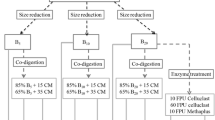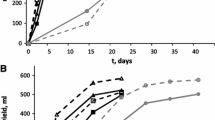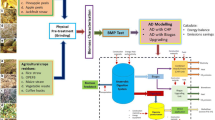Abstract
The biochemical methane potential (BMP) of peduncles, bulbs, and peels of three banana varieties (Grande Naine (GN; export dessert banana), Pelipita (PPTA; locally used plantain), and CRBP969 (phytopathogen resistant hybrid-plantain)) was investigated as an assessment of the bioconversion potential of these residues to renewable energy or biorefined chemicals. Biogas production was monitored manometrically for 132 days and its composition was analyzed using gas chromatography. The BMP ranged from 162 to 257 ml_CH4/g_DM for peduncles, from 228 to 304 ml_CH4/g_DM for bulbs, and from 208 to 303 ml_CH4/g_DM for green peels, with methane content of the biogas in the range 56 to 60 %. Bulbs and green peels showed bioconversion yields of 95 % of the chemical oxygen demand (COD). The GN variety was generally more biodigestible than PPTA, which appeared richer in lignocellulosic fibres. The peels biodigestibility reduced with maturation and was already limited to 56 % of the COD at the yellow stage. The energy resource available in the residues of banana production is very significant, increasing by 91 % the energy resource offered by banana crop, which is generally limited to the nutritional value of the fruit pulp. In the study case of the African leading producer of bananas and plantains (Cameroon), the amount of available residues from the sole export variety GN could feed about 4 % of the annual electricity consumed by the country, i.e., a supply of electricity to an additional 9 × 105 people. Such valorization of the residual banana biomass could help banana-producing countries to become less dependent on fossil fuels and less prone to energy shortages.




Similar content being viewed by others
Abbreviations
- AD:
-
Anaerobic digestion
- BMP:
-
Biochemical methane potential
- CARBAP:
-
African Research Centre on Bananas and Plantains
- CHP:
-
Combined heat and power plant
- CRBP:
-
Previous name of CARBAP
- COD:
-
Chemical oxygen demand
- DM:
-
Dry matter
- FM:
-
Fresh matter
- GC:
-
Gas chromatography
- GN:
-
Grande Naine
- PHP:
-
Plantations Haut Penja
- PPTA:
-
Pelipita
- VS:
-
Volatile solids
References
Kouassi K.S. (2001). La création variétale par pollinisation manuelle chez les bananiers (Musa spp.). Mémoire DEA. Université d’Abidjan-Cocody, Côte d’Ivoire, 50p.
Stover RH, Simmonds NW (1987) Classification of banana cultivars. In: Stover RH, Simmonds NW (eds) Bananas, 3rd edn. Wiley, New York, pp. 97–103
Robinso JC (1996) Distribution and importance; taxonomic classification, cultivars and breeding. In: Robinson JC (ed) Banana and plantains. CAB International, Wallingford, pp. 1–33
FAO (2010) FAOSTAT statistics data base. Agriculture. FAO, Rome.
Kamdem I, Tomekpe K, Thonart P (2011) Production potentielle de bioéthanol, de biométhane et de pellets a` partir des de’chets de biomasse lignocellulosique du bananier (Musa spp.) au Cameroun. Biotechnol. Agron. Soc. Environment 15(3):461–473
FAO (2001). FAOSTAT statistics database, Agriculture, Rome, Italy.
FAO (2002). FAOSTAT statistics data base, Agriculture, Rome, Italy.
FAO (2012) Bananas production in Cameroon. FAOSTAT statistics database. Accessed 12 July 2016.
Ward AJ, Hobbs PJ, Holliman PJ, Jones DL (2008) Optimisation of the anaerobic digestion of agricultural resources. Bioresour Technol 99:7928–7940
Batstone DJ, Jensen PD (2011) Anaerobic processes. In: Wilderer P (ed) Treatise on water science. Elsevier, Oxford, pp. 615–639
Angelidaki I, Karakashev D, Batstone DJ, Plugge CM, Stams AJM (2011) Biomethanation and its potential. Methods Enzymol 494:327–351
Weiland P (2009) Biogas production: current state and perspectives. Appl Microbiol Biotechnol 85:849–860
Kalia VC, Sonakya V, Raizada N (2000) Anaerobic digestion of banana stem waste. Bioresour Technol 73:191–193
Chanakya HN, Sreesha M (2012) Anaerobic retting of banana and arecanut wastes in a plug flow digester for recovery of fiber, biogas and compost. Energ Sust Dev 16:231–235
Bardiya N, Somayaji D, Khanna S (1996) Biomethanation of banana peel and pineapple waste. Bioresour Technol 58:73–76
Gunaseelan N (2004) Biochemical methane potential of fruits and vegetable solid waste feedstocks. Biomass Bioenergy 26:389–399
Clarke WP, Radnidge P, Lai TE, Jensen PD, Hardin MT (2008) Digestion of waste bananas to generate energy in Australia. Waste Manag 28:527–533
Tumutegyereize P, Muranga FI, Kawongolo J, Nabugoomu F (2011) Optimization of biogas production from banana peels: effect of particle size on methane yield. Afr J Biotechnol 10(79):18243–18251
Kalemelawa F, Nishihara E, Endo T, Ahmad Z, Yeasmin R, Tenywa M, Yamamoto S (2012) An evaluation of aerobic and anaerobic composting of banana peels treated with different inoculums for soil nutrient replenishment. Bioresour Technol 126:375–382
Abdul RS, Rasool BM, Khan MB (2013) Anaerobic biodegradability and methane potential of crop residue co-digested with buffalo dung. Mehran Univ Res J Eng Technol 32:0254–7821
Kamdem I, Hiligsmann S, Vanderghem C, Bilik I, Paquot M, Thonart P (2013) Comparative biochemical analysis during the anaerobic digestion of lignocellulosic biomass from six morphological parts of Williams Cavendish banana (Triploid Musa AAA group) plants. World J Microbiol Biotechnol 29:2259–2270
Awedem WF, Achu MBL, Happi ET (2015) Nutritive value of three varieties of banana and plantain blossoms from Cameroon. Greener J Agri Sci 5(2):052–061. doi:10.15580/GJAS.2015.2.012115009
Tiappi DMF, Happi ET, Tchokouassom R, Vanderghem C, Aguedo M, Gillet S, Jacquet N, Danthine S, Magali D, Aurore R (2015) Genotype contribution to the chemical composition of banana rachis and implications for thermo/biochemical conversion. Biomass Conv Bioref. doi:10.1007/S13399-015-0158-6
Clesceri LS, Greenberg AE, Eaton AD (1999) Standard methods for examination of water & wastewater, 20th edn. Am Public Health Assoc, Washington, DC
Wang YS, Byrd CS, Barlaz MA (1994) Anaerobic biodegradability of cellulose and hemicellulose in excavated refuse samples using a biochemical methane potential assay. J Ind Microbiol 13:147–153
Cordeiro N, Oliveira L, Evtuguin DV, Torres IC, Silvestre AJD (2007) Chemical composition of different morphological parts from ‘Dwarf Cavendish’ banana plant and their potential as a non-wood renewable source of natural products. Ind Crop Prod 26(2):163–172. doi:10.1016/j.indcrop.2007.03.002
Mohapatra D, Sabyasachi M, Namrata S (2010) Banana and its by-products utilization: an overview. J Sci Ind Res 69:323–329
Hills DJ, Nikano K (1984) Effect of particle size on anaerobic digestion of tomato solid waste. Agric Wastes 10:285–295
Khanna S. (1992). Methanogenesis from agricultural byproducts. Final report submitted to MNES Govt. of India, New Delhi. No. 5/2/23-89-BP.
Happi ET, Andrianaivo RH, Wathelet B, Tchango TJ, Paquot M (2007) Effects of the stage of maturation and varieties on the chemical composition of banana and plantain peels. Food Chem 103:590–600
Ngoh NG, Kendine VC, Womeni HM (2014) Physicochemical and mineral composition of dessert banana peduncle juice during conservation at ambient temperature. Greener J Agri Sci 4(8):326–337. doi:10.15580/GJAS.2014.8.072014308
Ilori MO, Adebusoye A, Lawal AK, Awotiwon OA (2007) Production of biogas from banana and plantain peels. Adv Environ Biol 1(1):33–38
Uhuegbu CC, Onuorah LO (2014) Production of biogas from plantain peels. Res J Eng Appl Sci 3(2):145–150
Cordeiro N, Oliveira L, Evtuguin D, Silvestre AJD (2009) Structural characterization of stalk lignin from banana plant. Ind Crop Prod 29(1):86–95. doi:10.1016/j.indcrop.2008.04.012
Lassoudière A. (2007) Le bananier et sa culture. Publisher Quae, Versailles, France. ISBN: 978-2-7592-0046-7. pp. 383
CIA (2015). Central Intelligence Agency. https://www.cia.gov/library/publications/the-world-factbook/geos/cm.html. Accessed 20 April 2015.
United States Department of Agriculture. USDA Food Composition Databases. https://ndb.nal.usda.gov/ndb/. Accessed 10 June 2016.
Wandji FDY (2007). Le Cameroun et la question énergétique. Éditions l’Harmattan. Paris, France.
Mayer F, Gerin PA, Noo A, Foucart G, Flammang J, Lemaigre S, Sinnaeve G, Dardenne P, Delfosse P (2014) Assessment of factors influencing the biomethane yield of maize silages. Bioresour Technol 153:260–226
Assobacam (2015). Association bananière du Cameroun. http://www.assobacam.com/index.php/exportations 2014. Accessed 22 Jan 2015.
Achilles, W., de Baey-Ernsten, H., Frisch, J., Fritzsche, S., Fröba, N., Funk, M., Grimm, E., Hartmann, W., Kloepfer, F., Peters, R., Sauer, N., Schwab, M., Siegel, F., Weiershaüser, L., Witzel, E., 2002. Betriebsplanung Landwirtschaft 2002/2003, Datensammlung, Kuratorium für Technik und Bauwesen in der Landwirtschaft—KTBL, 18. Auflage, Darmstadt, ISBN 3-7843-2141-0, p. 379.
Gerin AP, Vliegen F, Jossart J-M (2008) Energy and CO2 balance of maize and grass as energy crops for anaerobic digestion. Bioresour Technol 99:2620–2627
Nguyena VH, Topnoa S, Balingbing C, Nguyenb VCN, Röder M, Quilty J, Jamieson C, Thornley P, Gummerta M (2016) Generating a positive energy balance from using rice straw for anaerobic digestion. Energy Rep 2:117–122
Fachverband Biogas e.V. (2015) German biogas association. http://www.biogas.org/edcom/webfvb.nsf/id/DE_Branchenzahlen/$file/16-07-28_Biogas_Branchenzahlen-2015_Prognose-2016_engl_final.pdf. Accessed 6 October 2016.
Acknowledgments
Financial support and scholarship for this study (Project “Programme Interuniversitaire Cible: Valorization of banana residues and contribution to local sustainable development”) were provided by the Commission Universitaire pour le Développement (CUD) and Wallonie-Bruxelles International (WBI) from Belgium. The authors are also grateful to the research staff from the Bioengineering Unit (UCL, Belgium), to the post-harvest technology laboratory, CARBAP-Cameroon, and to the laboratory for Food Science and Metabolism, LabSAM-Cameroon. A great acknowledgment to Thomas Nicolay, Florian Tiappi, Achu Mercy Bih, and Raphaël Tchokouassom for their technical support and assistance.
Author information
Authors and Affiliations
Corresponding author
Rights and permissions
About this article
Cite this article
Wobiwo, F.A., Emaga, T.H., Fokou, E. et al. Comparative biochemical methane potential of some varieties of residual banana biomass and renewable energy potential. Biomass Conv. Bioref. 7, 167–177 (2017). https://doi.org/10.1007/s13399-016-0222-x
Received:
Revised:
Accepted:
Published:
Issue Date:
DOI: https://doi.org/10.1007/s13399-016-0222-x




